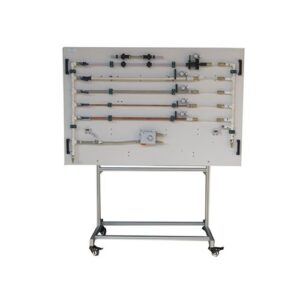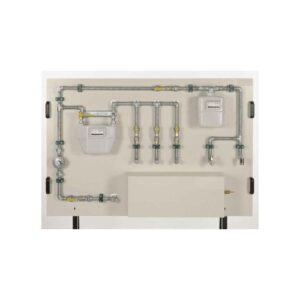ASL352 Free and Forced Convection Unit school teaching equipment Thermal Laboratory Equipment
- Description
The heat transport is substance-bound. The heat transport is substance-bound. In the convection process, the whole fluid is moving. So-called bulks of fluid move (and thus transfer heat) from warm zones into cold zones The different temperatures lead to density differences in the fluid so that a flow develops. In the case of free convection, the density differences result in a rather slow flow of the fluid with a more intensive heat transfer. In the case of forced convection, The flow is generated by a fan or pump. In this case, the heat transfer to fluid particles is lower, but more heat is transported than with free convection due to the much larger mass flow.
The core element of the SL 352 experimental unit is a vertical duct into which a heating element is inserted. Three flows elements with different surfaces are available: a flat plate, a tube bundle Or fins. For experiments on forced convection, an additional fan has to be activated.
Sensors record the flow velocity of the air, the heating power and the temperatures at all relevant points.
The well-structured instructional material sets out the fundamentals and provides a step-by-step guide through the experiments.
Learning Objectives / Experiments
– free and forced convection
– heat transfer at different surfaces:
Flat plate
* pipe bundle
* fins
– temperature distribution in the heat exchanger
– determination of the Reynolds and Nusselt numbers
– calculation of heat transfer coefficient for free and
Forced convection
2.Technical details
Specification
[1] heat transfer in the air duct by free and forced convection
[2] air duct with axial fan
[3] 3 heating elements with different surfaces: flat plate, tube bundle or fins
[4] sensors measure temperatures (upstream and downstream of the heating element and inside the heating element), flow velocity of the air and heating power
Technical Data
Air duct
– flow cross-section: 120x120mm
– height: 1m
Axial fan
– max. volumetric flow rate: 170m3/h
– max. pressure difference: 54Pa
– power consumption: 6,5W
– nominal speed: 2900min-1
Heating elements
– temperature limitation: max. 150°C
– max. heating power: 200W
– surface of flat plate: 140cm2
– surface of tube bundle: 980cm2
– surface of fins: 1400cm2
Measuring ranges
– flow velocity: 0…10m/s
– temperature: 2x 0…100°C, 1x 0…200°C
– heating power: 0…375W
Scope of Delivery
1 experimental unit
3 heating elements
1 display and control unit
1 set of instructional material











